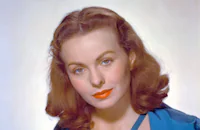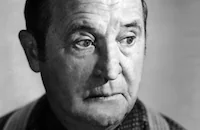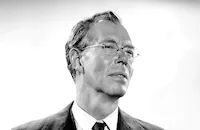Cheaper by the Dozen

Brief Synopsis
Cast & Crew
Walter Lang
Clifton Webb
Jeanne Crain
Myrna Loy
Betty Lynn
Edgar Buchanan
Film Details
Technical Specs

Synopsis
Ann Gilbreth, the oldest of the twelve children of Frank and Lillian Gilbreth, begins to relate some episodes from her family's history. In 1921, when Ann is sixteen, the family lives in Providence, Rhode Island, where her father, an industrial engineer, is also an efficiency expert utilizing time and motion studies. Frank informs the family that they are moving to Montclair, New Jersey. Once the family is established there, Frank chairs one of his regular family council meetings to assign the children various chores that will assist Lillian and the two servants, Mrs. Monahan and Jim Bracken. When Frank goes to enroll five of the children in school, he tells the principal that he would like to meet the teachers, explaining that he wants the children placed in higher grades as their mental ages exceed their physical ages thanks to the complete home training program he has devised for them. Teenagers Ann and Ernestine, who will be attending a different school, have accompanied their father and are mortified when, though fully clothed, he demonstrates his time efficient method for taking a bath in the time it takes to play a phonograph record. Some time later, a doctor's car is parked in front of the Gilbreths' house, which normally signals the arrival of a new baby, but this time means that several of the children have whooping cough. While he is there, Dr. Burton examines everyone's tonsils and decides they should all come out, including Frank's. Always looking for opportunities to use time more efficiently, Frank decides to make a filmed record of the surgeries in order to help physicians eliminate wasted motions. The stalwart Frank thinks there is nothing to a tonsillectomy, but when it comes his turn to visit the operating room that has been set up in the house, he emerges from the procedure weak and shaken, a situation that is exacerbated by the revelation that the cameraman, Mr. Higgins, forgot to put film in the camera. Some time later, while several of the children are receiving a music lesson and are mangling their rendition of "Love's Old Sweet Song," Frank tells Lillian that he may be invited to speak on motion study at an international management conference in Prague, Czechoslovakia. Lillian then reminds him that she is on her way to the hospital to have another child. They name the child Robert, and he rounds out the "even" dozen children they planned of six boys and six girls. At another family council meeting, young William moves that they buy a dog, a motion that is carried, even though the chairman, Frank, objects. The dog, whom the family names "Mr. Chairman," develops a great affection for Frank. One day, a neighbor suggests that Lillian, who also had a career as a psychologist and industrial consultant, might serve as president of a new local chapter of Planned Parenthood, and is chagrined to find out how many children the Gilbreths have. Every summer, the family spends their holiday on Nantucket Island. One summer, Ann is attracted to young Tom Black, who attends her school, and, along with Ernestine, Ann is upset that Frank forbids them to wear bathing suits that reveal their knees. Back home, when Ann is invited to the senior prom, Frank insists on going along as a chaperone, and because the family car will not start, Frank has to go into the rumble seat of Tom's jalopy. Despite Ann's fears, Frank ends up being the hit of the dance, with many of Ann's friends wanting to dance with him. Later, Frank prepares for his two-month-long trip to Europe. After saying goodbye to the family, Frank suddenly and totally unexpectedly, collapses at the Montclair station and dies. Lillian calls a family council meeting of the older children and tells them that the money Frank left has had to go back into the business. She has talked with their grandmother in California who wants them to live with her. Their only other choice would be for Lillian to take over father's business, but that would mean that the family would have to live very simply and the children would have to help more around the house. Lillian then decides to go to Prague and London to give Frank's speeches. The children all agree that they should try to stay together and that they will manage things well. Ann finishes her account of the family history by saying that her mother did carry on Frank's work, became the foremost woman industrial engineer in the world and, in 1948, was named America's "Woman of the Year."

Director

Walter Lang
Cast

Clifton Webb

Jeanne Crain

Myrna Loy

Betty Lynn

Edgar Buchanan

Barbara Bates

Mildred Natwick
Sara Allgood
Anthony Sydes
Roddy Mccaskill
Norman Ollestad
Patti Brady
Carol Nugent
Jimmy Hunt
Teddy Driver
Betty Barker

Evelyn Varden

Frank Orth
Craig Hill
Virginia Brissac

Walter Baldwin
Bennie Bartlett
Syd Saylor
Ken Christy
Mary Field
Caryl Lincoln
Eula Guy
Lovyss Bradley
Jane Lee
Eleanor Moore
Anita Gegna
Henry Wise
Ramona Oliver
Dulce Daye
Vincent Graeff
Billy Engle
Tom Mcquillan
Lyn Thomas
Denise Courtemarche
Tina Thompson
Juey Ann Whaley
Tramp, A Dog
Lillian West
Peggy O'connor
Joyce Otis
Harmon Stevens
Ted Crane
Ralph Hodges
Richard Taylor
Crew
Jerry Bryan
Bob Carleton
Linda Cross
Leonard Doss
Doris Drought
Eli Dunn
Gus Edwards
A. F. Erickson
Paul S. Fox
Leland Fuller
Byron Gay
Gaston Glass
Roger Heman
Lillian Hokom
Henry Kailimai
Charles E. King
Charles Lemaire
Thomas Little
Jack Mahoney
Bud Mautino
Cyril Mockridge
James Lyman Molloy
James V. Monaco
Lionel Newman
Ben Nye
Emmett Schoenbaum
Fred Sersen
Leon Shamroy
Herbert Spencer
Edward Stevenson
John Sturtevant
Lamar Trotti
Lamar Trotti
E. Clayton Ward
J. Watson Webb Jr.
Percy Wenrich
Lyle Wheeler
Darryl F. Zanuck

Videos
Movie Clip



Trailer
Film Details
Technical Specs

Articles
Cheaper by the Dozen (1950)
Webb, who had begun his career as a ballroom dancer and became a star of the Broadway musical stage in the 1910s and 1920s, had also become a Hollywood star by the mid-1940s. In 1948, he created the character of the comically supercilious babysitter Mr. Belvedere in Sitting Pretty, which was so successful that it spawned two Mr. Belvedere sequels and established Webb's screen persona.
Loy's screen image as the perfect wife had also evolved, from the glamorous Nora Charles of the Thin Man series in the 1930s, to a more mature version in films such as The Best Years of Our Lives (1946). When she appeared in Cheaper by the Dozen, Loy was 45 and her days as a leading lady were behind her. She didn't really mind, since she had other interests. She was active in liberal politics, and she had been appointed as a member of the U.S. National Commission for UNESCO. But she still needed to make a living, and she was an admirer of the real Lillian Gilbreth, so even though some of her contemporaries warned her that playing a mother of 12 was career suicide, she was glad to do it.
20th Century Fox contract player Jeanne Crain, who played the eldest Gilbreth daughter (and was billed above Loy), was less pleased with her role. "After having the best role of my career in Pinky [1949], I was absolutely crushed when they cast me as a teenage ingénue," she told Loy's biographer James Kotsilibas-Davis. "Well, I accepted the role and the whole thing turned out to be a joyful association." A huge fan of Loy's, Crain was at first intimidated to be working with her idol, but Loy went out of her way to put her at ease. Crain observed first-hand what a consummate screen actress Loy was. "When Myrna does a scene, she appears to be so low-key and doing practically nothing discernible, yet when you sit in the rushes the next day, she zings out of the screen....It's as though she has something, an elusive quality, that only the camera can see."
Crain went on to say that Webb was just the opposite, as a person and as an actor, calling him "temperamental, bombastic and dictatorial." But she added, "Myrna was the perfect foil for Clifton, letting him fly all over the place while she remained serene and submissive and really in charge of the whole thing. Their surprising chemistry made the picture believable and successful."
Loy agreed with Crain's description of Webb, an inveterate scene stealer, who used stage tricks like moving around and forcing her to move off her marks. After cinematographer Leon Shamroy blew up at Loy for ruining the shot, a chastened Webb behaved, although he never apologized. Loy shrugged it off, and they remained friends, but according to Loy, when Webb watched her do an emotional scene he was not in, he accused her of trying to steal the film from him.
Reviews for Cheaper by the Dozen were good, with one critic calling it "engaging, heartwarming, upbeat and positive in the true sense of that much-abused adjective." It performed so well at the box office that two years later Loy and Crain reprised their roles in a sequel, Belles on Their Toes (1952). Director: Walter Lang
Producer: Lamar Trotti
Screenplay: Lamar Trotti, based on the novel by Frank B. Gilbreth, Jr. and Ernestine Gilbreth Carey
Cinematography: Leon Shamroy
Editor: J. Watson Webb, Jr.
Costume Design: Edward Stevenson
Art Direction: Leland Fuller, Lyle Wheeler
Music: Cyril Mockridge, Alfred Newman
Cast: Clifton Webb (Frank Bunker Gilbreth), Jeanne Crain (Ann Gilbreth), Myrna Loy (Lillian Gilbreth), Betty Lynn (Deborah Lancaster), Edgar Buchanan (Dr. Burton), Barbara Bates (Ernestine Gilbreth), Mildred Natwick (Mrs. Mebane), Sara Allgood (Mrs. Monahan).
C-87m. Closed Captioning.
by Margarita Landazuri

Cheaper by the Dozen (1950)
Quotes
Trivia
Based on the real-life Gilbreth family. Daughter Mary died from a childhood illness; the movie includes a Mary but keeps her somewhat in the background with no lines.
The big house the family moves to in Montclair is the same house set originally built for 'Judy Garland' 's family in Meet Me in St. Louis (1944). Fox didn't have an appropriate standing outdoor set so they rented time on the "St. Louis Street" on MGM lot #2.
In the movie, the last child born is a boy named "Robert". But in real life, the last Golbreth child was a girl named "Jane". There was a son named Robert, but he was the second-to-last child born.
Notes
The film begins with the following written statement: "This is the True Story of an American Family." According to documents in the Twentieth Century-Fox Records of the Legal Department at the UCLA Arts-Special Collections Library, the studio purchased the rights to Cheaper By the Dozen, a "non-fictional novel," in February 1949 for $75,000. The fee was divided thus: $55,000 to the authors and $20,000 divided equally between Dr. Lillian Gilbreth and the other still living children. An additional sum of $25,000 was paid based on the book's sales. A Hollywood Reporter news item in January 1950 reported that Cheaper By the Dozen was the first Twentieth Century-Fox film to have sound recorded magnetically onto 35mm film.
In an interview published in Los Angeles Examiner on February 4, 1953, Dr. Lillian Gilbreth stated, "When my husband passed away 29 years ago, I was faced with the responsibility of raising my family and providing a living for them. It wasn't an easy task. Luckily, my health was good and my children cooperative. I met the challenge because I had a burning desire to succeed, first as a mother, and secondly as a business woman." Gilbreth was a psychologist by profession and lived into her 90's.
Co-authors Ernestine Gilbreth Carey (1908-2006) and Frank B. Gilbreth, Jr. (1911-2001), portrayed respectively in the film by Barbara Bates and Norman Ollestad, were younger siblings of Ann Gilbreth Barney, the oldest of the twelve Gilbreth children, portrayed in the film by Jeanne Crain. Ann died in 1987 at age 81. On May 30 1993 the Montclair, New Jersey Sunday Star-Ledger published an article about a reunion of six of the eight surviving family members and revealed that the book's initial publication in 1948 by the Thomas Y. Crowell Company occasioned a phenomenal thirty-nine printings, and that a 1963 edition, which included an updated chapter on the children's lives as adults, was also printed several times. Some reviews list the character played by Betty Lynn as "Libby"; this was changed just prior to production to "Deborah". A radio version, starring Clifton Webb, was broadcast on Lux Radio Theatre on May 7, 1951. In 1952, Twentieth Century-Fox released Belles on Their Toes, a sequel starring Loy, Crain and Debra Paget and directed by Henry Levin. In 2003, 20th Century Fox released a remake of Cheaper by the Dozen, directed by Shawn Levy and starring Steve Martin and Bonnie Hunt. As of spring 2005, a sequel to that film, entitled Cheaper by the Dozen 2, was in pre-production.

Miscellaneous Notes
Released in United States Spring April 1950
Released in United States Spring April 1950














